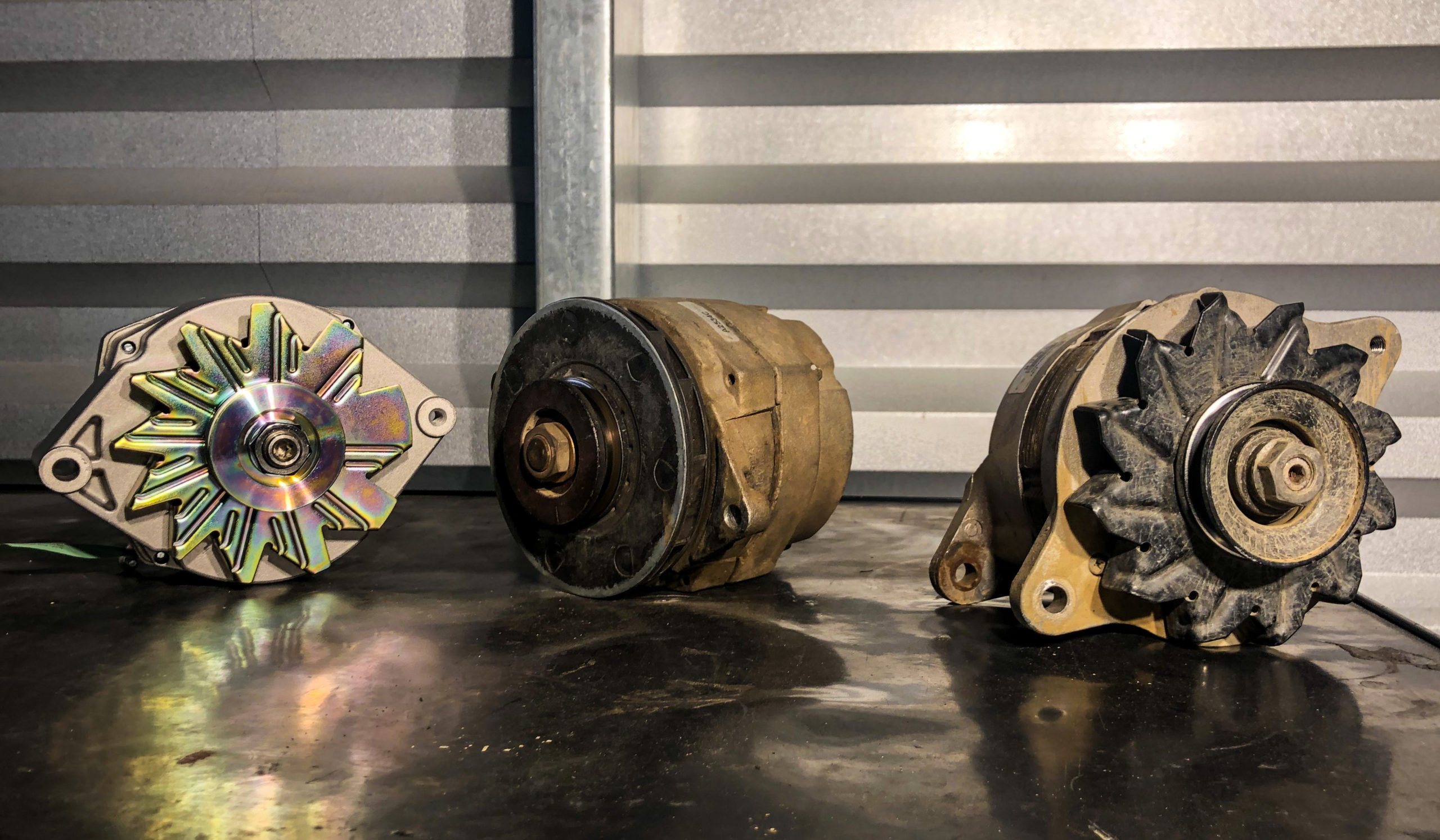Nowadays, the electrical system on our rigs require better alternators to power the air compressor, winch, stereo, lighting, and auxiliary items like onboard refrigerators and inverters. Moreover, although there are several alternator upgrades available, the best alternator upgrade you could conduct on your Toyota FJ40 is to install a GM 10si “one wire” internally regulated alternator which produces 140-160 amps.
What is a 10si Alternator?
The 10si alternator was a commonly used option for many vehicles built in the 1970s to 1980s. They were made by Delco Remy and found on most General Motors cars and trucks by the mid-’70s; the first being the 1969 Corvette as a way to integrate the external voltage regulator internally, into the alternator. This made for a more efficient electrical charging system without the need for an external regulator.
10si is not a part number, but rather a model designation by the manufacturer, Delco Remy. “SI” stands for “system integrated” with the regulator being located inside the alternator.
10si Alternators Have Better Amp Output at Lower RPMs
If you do a lot of off-roading, particularly crawling, you’ll appreciate more amps at lower RPMs. One of the first things I noticed when I started monitoring my electrical system was that my stock alternators were not charging the system at idle. I had a modern amp gauge that would show a discharge on the battery at idle or slow rock crawling. Now add a warm/hot engine bay and the voltage drops get even worse.
With a 10si alternator, there has always been a constant higher voltage output while wheeling. This keeps the system happy when running my stereo and electric fan.
Your Stock Alternator Requires an External Regulator that is NOT very efficient
If you look in your engine bay on the firewall near the steering shaft you will see a box plugged into your factory wire harness. That box is your voltage regulator. The gatekeeper between your system requests for amperage, and the alternator production. With a stock external regulator, your alternator will have a plug on the back. The single bigger wire is the output, so visualize a water spigot. Your water nozzle is the output wire and the turn valve is your regulator managing the flow or amount produced. Without getting too technical, the voltage regulator controls magnets within the alternator. Moving them closer or farther away depending on the request of amperage.
External regulators get hot and become less efficient when temperatures increase under the hood.
Toyota Parts are Expensive and Hard to Come by When Out on the Trail
Once you convert to the GM one wire alternator you’ll be able to easily find one at any local auto parts store. These alternators are readily available and have come in so many cars and trucks over the years. I can’t say that this is the case with the traditional Toyota Denso alternator and its external regulator. I had to order mine from a major land cruiser website and wait for shipping. This is not what you want to do if you’re on a trip miles from home or in another State.
Land Cruiser Alternator vs. 10si Alternator
| Alternator Type | Amperage Output | External Regulator | Cost |
| Land Cruiser Remanufactured | 55 Amps | Yes | $250.00 |
| 10si alternator with comparable amperage output | 60 Amps | No | $34.00 |
| Performance Alternator | 140 Amps | No | $132.00 |
The stock rebuilt alternator for your original FJ40 is going to cost around $235. It would be a good idea to buy a new voltage regulator to go along with it for another $15. That means you’ll spend $250 for the factory setup but only producing 40-55 amps.
For almost half the cost you could have a GM 10si one wire alternator that is producing 140 amps. Want to keep some bucks in your pocket? An inexpensive option 60 amp 10si alternator would only set you back $34 at the counter of your local auto parts store.
Would higher Amp Alternators Burn up my Wire Harness?
Going down the search engine rabbit hole you can get conflicting information about the use of high amp alternators. Some of the information you might find are: “That high amp output will burn up your old wire harness, “ “That alternator will just be pushing so many amps throughout the system,” It does if that old wire harness has a high amperage request at the other end of it. If you are wiring a high amperage stereo system power input through a 50-year-old small gauge wire, then yes you will have issues. But the alternator is just delivering what is requested, through the only path you have given it.
On the other side, your stock reverse light that has been factory wired since day one will be able to handle the high output amperage the alternator can deliver. That is because the little bulb is just asking for 5 or so amps to be delivered from the 50-year-old crusty wire that was meant to deliver it. That reverse light bulb will never ask for 100 amps to be delivered to itself through the factory 18 gauge wire. Thus the factory harness and all factory uses will be fine as long as you don’t add something that asks for 100 amps through a factory inadequate gauge wire.
How Much Amps Do I Need?
Well, technically you would have to build a spreadsheet of every item that creates a draw on the electrical system to come up with that number. I knew that my factory system required the stock 40 amp alternator. I would use that as your baseline. You consider that the first 40 amps of any alternator you purchase is going to supply our factory requirement. From there you can create a list of everything you’ve added to the system and their amp requirements. For my system I’ve added these items:
- Electric Fan – 10 amps
- KC Daylighter Driving Lights – 4 amps total
- Electric Air Compressor – 49 amps
- Alpine Amplifier – 15 amps
- Rock Lights – 5 amps
- Warn Winch – 358 amps (exception – your winch will use amperage from your battery and alternator when used)
What if I Buy More Amperage Than I Need?
Well, that is great! Now your alternator will not have to work as hard. So you purchase the 140 amp alternator but when you add up the amp use of everything on your rig it only comes out to say 60-70amp. Well, now your alternator will run better, running at 50% capacity. Switching to say a 90 alternator means it could be running at 75% capacity. The only downside is you might have spent $40 bucks more than you needed to. But hey, when you do mount a winch or fridge you will be thankful you’ve already got the amps.
Should I Buy an Alternator That Has the Same Output as my Winch can Request?
I mean that would be great. If you’ve got the money you can go get the big badass alternator that is going to be $300-400 or higher. I believe there is a balance. I mean you have a battery that is able to store and deliver the amperage difference needed when you’re running your winch. Winches have a chart that shows you the draw based on its use, or how much amperage it is drawing while pulling. I’ve found that you’re paying $1 per amp up to the 140-160 amp alternator sizes. It starts to get more expensive per amp when you are buying alternators with 200+ amp output. The winch is the exception. You will use your winch once a trip. I know that is high but great for the example. So there will be one time on a trip where you turn off your radio, lights, and have an amperage draw from the alternator and battery. Worst case on long hard pulls you have to wait so the alternator can “fill” up the battery reserve before you start pulling again.
An Alternator Runs the Rig, The Battery Stores Power For Extra Use and Time
The job of the alternator is to provide a constant flow of 14 volts to the system through the canals of your wire system. When an accessory is turned on and asking for the power, it is requesting a flow of those 14 volts in amperage.
Startup
At startup, the alternator is produced 0 volts and cannot disburse any amperage requests that the system may be asking for. Your battery is the stored energy that is used to get things going. The turn of your key will signal your ignition to dump power from the battery to your starter to begin cranking. Technically once cranking, your alternator is producing, but very very little at those low RPMs. It will not produce enough to fill the battery back up if you continue to crank at low RPMs. Hence that’s why you lose all battery if you crank and crank and can’t get started.
Amp Draw After Starting
Your engine is now running and at the very least your ignition coil is requesting a constant flow, or amperage, of the alternator’s 14 volts. Your foot is probably on the brake and your rear taillights are requesting some amperage. Moments later your radio is turned on,and amperage is flowing from the alternator, into the wire harness, and to these system objects
If The 10si Alternator is so Great, Are There Any Downfalls?
The alternator’s casing and lack of ventilation are what will restrict the maximum available amperage. When researching these alternators the cost-effective price point is about $150 for 140-160 amps. You’d roughly be spending $1 per amp. To get a 10si alternator with greater amperage you will end up spending more than that. Above the 160 amp range, companies manufacture or modify the back of the casing. Increasing the openings for ventilation. An alternator uses the fan in the front to pull air from the rear and through the internals for cooling. The stock casing just doesn’t have the available flow to cool higher amperage outputs.
Conclusion
The best alternator available for your FJ40 Toyota is the 10si by a longshot. First utilized in the 70’s this tried and true alternator revolutionized the Corvette, and your Toyota couldn’t be happier to see the 10si. Especially if you’re offroading, the amps and RPM work together harmoniously to keep the system happy. And the one standard one is an annoyance and is holding back your ride. You’ll never need to worry about the local store having it again. And if you can land one with the same winch output, you’re kicking your ride up a notch.




